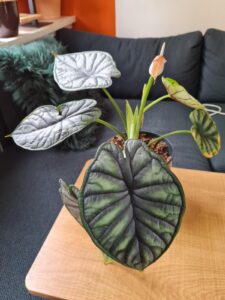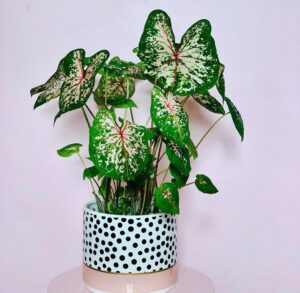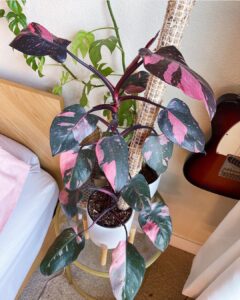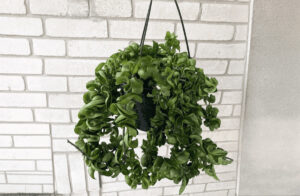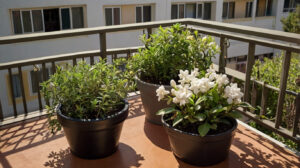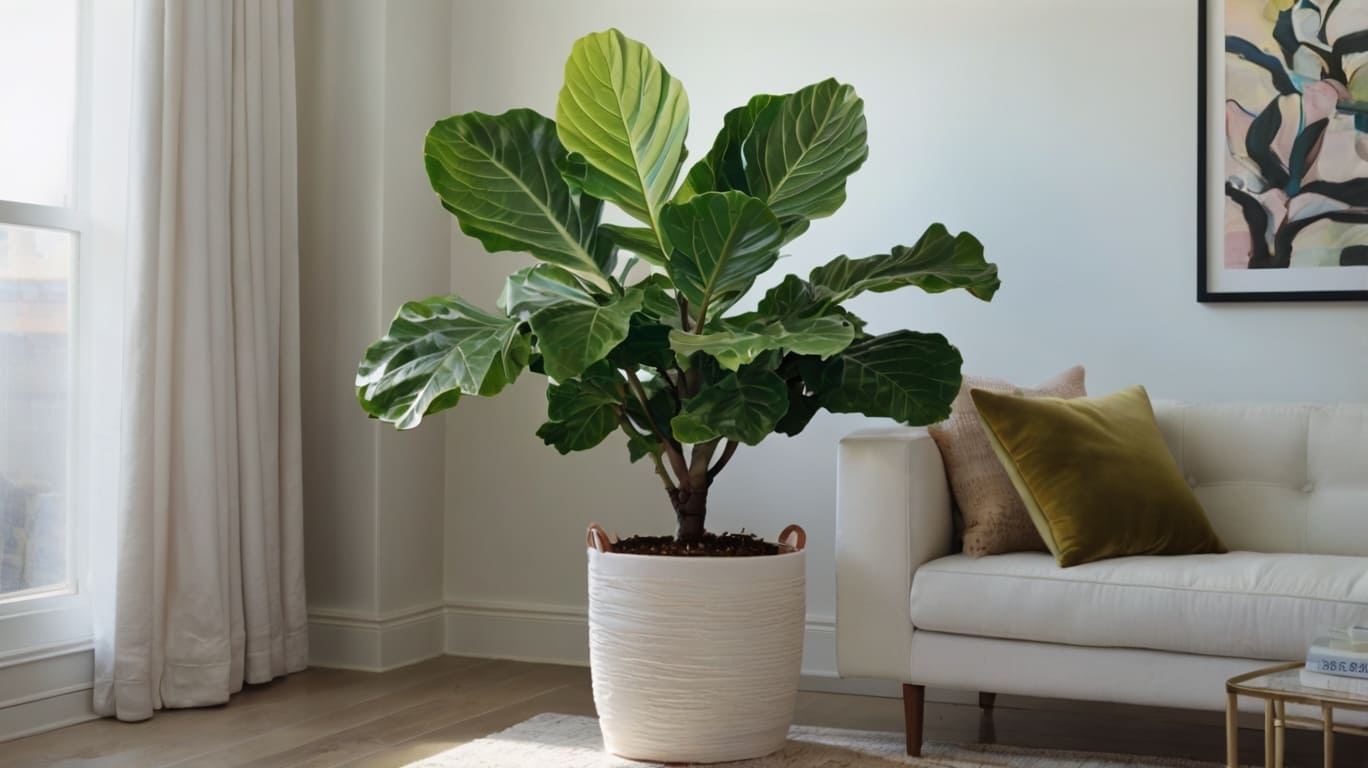
Your once-gorgeous fiddle leaf fig is looking rough around the edges, and you’re starting to wonder if it’s time to call it quits. Maybe you’re staring at brown spots, drooping leaves, or even worse—a cutting that went from Instagram-worthy to absolutely tragic in just a few days. Before you toss that plant in the trash, take a deep breath. Fiddle leaf figs are notoriously dramatic, but they’re also surprisingly resilient when you know what to look for.
I’ve been there too. My first fiddle leaf fig looked like it was auditioning for a plant horror movie after just two weeks in my apartment. The good news? Most struggling fiddle leaf figs can bounce back with the right care and a little patience. Let’s figure out what’s going wrong with yours and get it back to that glossy, green glory you fell in love with.
In this article
7 Signs Your Plant Might Be Struggling
Fiddle leaf fig cutting I tried to propagate in water. Was a beautiful healthy cutting now looks awful after less than a week
byu/Wild-Bug-6086 inhouseplants
Fiddle leaf figs aren’t subtle when they’re unhappy—they’ll practically wave red flags at you. Here are the most common distress signals your plant might be sending:
Brown spots or patches are probably the most obvious sign something’s wrong. These can appear anywhere on the leaves and range from small dots to large, mushy areas that look downright concerning.
Yellowing leaves that eventually drop off are another classic fiddle leaf fig tantrum. While some leaf drop is normal (they’re living things, after all), excessive yellowing usually means your plant is stressed about something.
Wilting or drooping leaves that don’t perk up after watering suggest your plant isn’t getting what it needs. This can happen even when the soil feels moist, which makes it particularly frustrating to diagnose.
Stunted or no new growth during growing season is a subtle but important sign. Healthy fiddle leaf figs should produce new leaves regularly during spring and summer.
Soft, mushy stems or roots are serious red flags that indicate rot has set in. This is especially common in propagation attempts that go sideways quickly.
Leaves falling off without warning can happen when your plant experiences sudden environmental changes or stress. Sometimes perfectly green leaves will just drop overnight.
White fuzzy growth or tiny moving spots on leaves or soil indicate pest problems that need immediate attention.
Reasons Why Your Plant Is Dying
Fiddle Leaf Fig revival tips!
byu/erinminns13 inhouseplants
Understanding why your fiddle leaf fig is struggling is half the battle. These plants have specific needs, and when those aren’t met, they let you know pretty dramatically.
Overwatering is hands down the biggest killer of fiddle leaf figs. These plants hate having wet feet, and soggy soil leads to root rot faster than you’d expect. Many people think they’re being helpful by keeping the soil constantly moist, but fiddle leaf figs actually prefer to dry out between waterings.
Poor drainage goes hand-in-hand with overwatering. Even if you’re watering correctly, if your pot doesn’t have drainage holes or your soil doesn’t drain well, water will sit around the roots and cause problems.
Inconsistent watering can stress your plant just as much as overwatering. Fiddle leaf figs like routine, so going from bone dry to soaking wet repeatedly will make them drop leaves in protest.
Low humidity is often overlooked, especially during winter months when indoor heating dries out the air. Fiddle leaf figs naturally grow in humid environments, so dry air can cause browning leaf edges and overall stress.
Inadequate light will slowly weaken your plant over time. These plants need bright, indirect light to photosynthesize properly. Too little light leads to weak, spindly growth and increased susceptibility to other problems.
Temperature fluctuations stress fiddle leaf figs more than most plants. They don’t like cold drafts, hot air from heating vents, or sudden temperature changes.
Transplant shock is common when you first bring your plant home or repot it. The change in environment can cause temporary leaf drop and stress.
RELATED: 10 High-Maintenance Plants We Regretted Buying (And You Might Too)
6 Ways to Revive Your Plant
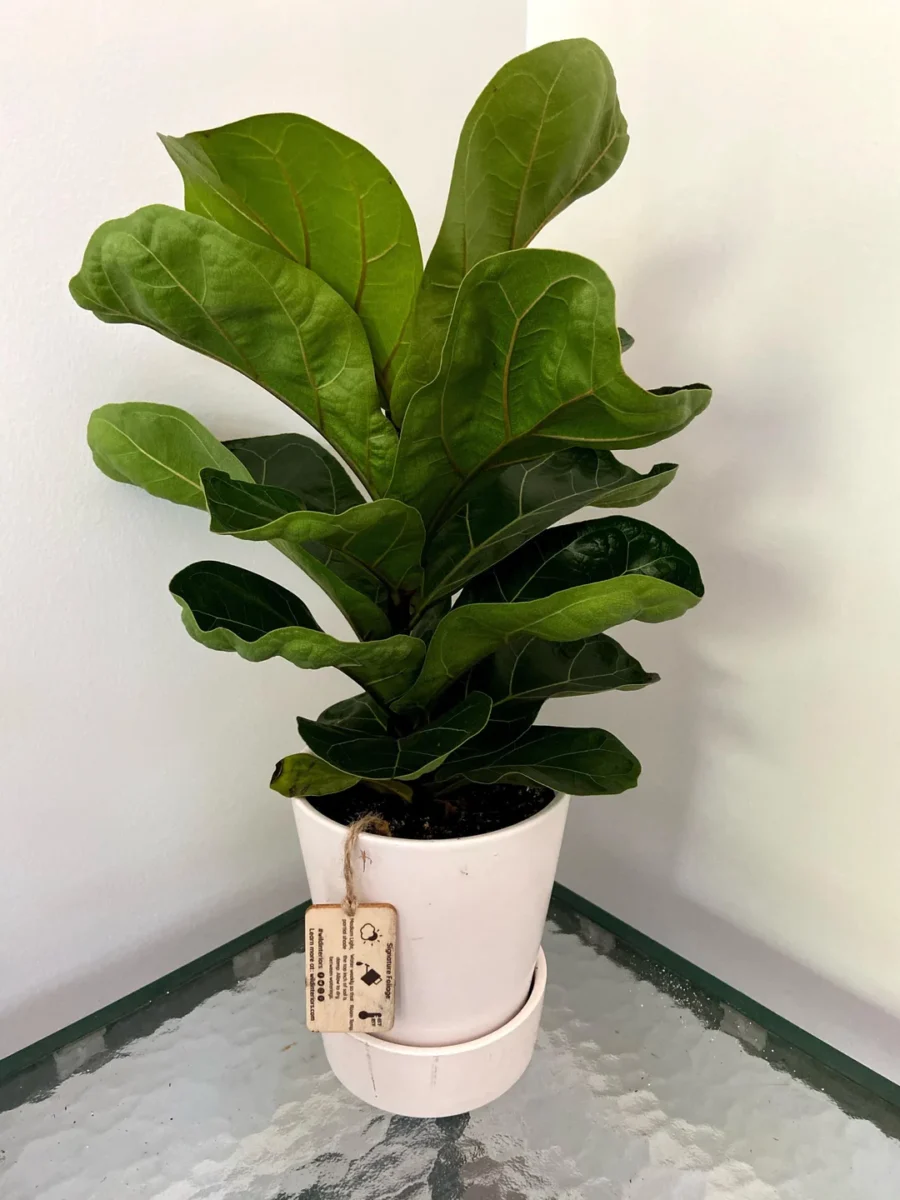
Now for the good stuff—how to actually save your struggling fiddle leaf fig. The key is addressing the underlying cause while giving your plant the support it needs to recover.
Adjust your watering schedule immediately. Stick your finger about 2 inches into the soil. If it’s wet, don’t water. If it’s dry, give it a thorough drink until water drains from the bottom, then don’t water again until the top 2 inches are dry. This usually means watering every 1-2 weeks, depending on your home’s conditions.
Improve drainage if necessary. If water sits on top of the soil or your pot doesn’t have drainage holes, it’s time for a change. Repot into well-draining potting mix and make sure your pot has holes in the bottom. You can also add perlite to heavy soil to improve drainage.
Move your plant to better light. Fiddle leaf figs need bright, indirect light for at least 6 hours a day. A spot near a large window (but not in direct sun) is ideal. If your plant has been in low light, gradually move it to brighter conditions over a week or two to avoid shock.
Increase humidity around your plant. Group it with other plants, use a humidifier, or place it on a tray of pebbles with water. Aim for 40-50% humidity if possible. You can also lightly mist the air around the plant (not the leaves directly) to help.
Remove damaged parts carefully. Use clean, sharp scissors to cut off any brown, mushy, or severely damaged leaves and stems. Cut back to healthy tissue, and don’t be afraid to be aggressive—your plant will focus energy on healthy growth instead of trying to save damaged parts.
Be patient with recovery. Fiddle leaf figs are slow to show improvement, sometimes taking several weeks or even months to bounce back. Don’t change your care routine too quickly—give your adjustments time to work.
Is Your Plant Dead or Dormant?
Can anyone help with my fiddle leaf fig? Most leaves have rust colored spots and some have big brown spots. Her leaves just don’t look healthy and I’m not sure what is wrong.
byu/the_greathambino inhouseplants
This is probably the most important question when you’re staring at a sad-looking fiddle leaf fig. The difference between dead and dormant can save you from throwing away a perfectly salvageable plant.
Check the stems and trunk first. Gently scrape a small section of bark with your fingernail. If you see green underneath, your plant is still alive. Brown or black all the way through usually means that section is dead, but other parts might still be viable.
Look for any signs of new growth. Even tiny bumps or nodes on stems can indicate your plant is preparing to put out new leaves. Dormant plants often look completely lifeless but still have these small signs of life.
Examine the root system if possible. Healthy roots should be white or light tan and feel firm. Mushy, black, or foul-smelling roots indicate rot, but even plants with some root rot can recover if there are still healthy roots.
Consider the season. Fiddle leaf figs naturally slow down growth during fall and winter, so what looks like decline might just be normal dormancy. Plants can look pretty rough during dormant periods but bounce back in spring.
Test the flexibility of branches. Dead branches will be brittle and snap easily, while dormant branches usually still have some flexibility. This isn’t foolproof, but it’s another clue about your plant’s condition.
Don’t give up too quickly. I’ve seen fiddle leaf figs that looked completely dead come back with just a few green nodes on the stem. Sometimes what looks like plant death is just a very dramatic dormant period.
Our Best Tips to Avoid Killing Another Plant
Looking for Some Fiddle Leaf Fig Advice
byu/TomBombadil25 inhouseplants
Let’s be honest—fiddle leaf figs have earned their reputation as finicky houseplants. But once you understand their preferences, they’re actually pretty predictable. Here’s how to set yourself up for long-term success.
Assess the Whole Plant—Not Just a Few Leaves
One of the biggest mistakes people make is panicking over a few problematic leaves while ignoring the overall health of the plant. Fiddle leaf figs naturally shed older leaves, especially lower ones, as they grow. A few yellow or brown leaves don’t necessarily mean your plant is dying.
Look at the big picture instead. Is the plant producing new growth? Are most of the leaves healthy and green? Is the stem firm and strong? A plant with 80% healthy foliage and some new growth is doing fine, even if it has a few problem leaves.
Pay attention to patterns too. If only the bottom leaves are yellowing, that’s usually normal aging. If new leaves are coming in small or deformed, that suggests a care issue that needs addressing. Random brown spots might indicate inconsistent watering, while browning edges often point to low humidity or water quality issues.
Healthy Plant Profile
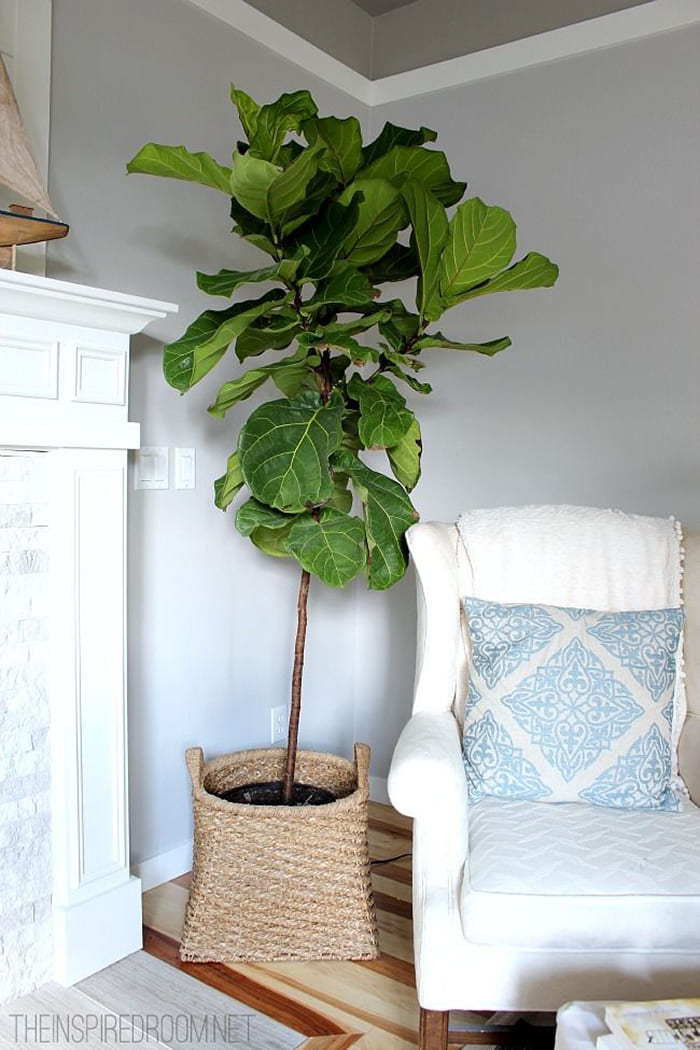
Knowing what a healthy fiddle leaf fig should look like makes it much easier to spot problems early. A thriving plant will have large, glossy leaves that feel thick and substantial. The color should be a rich, vibrant green without any dullness or yellowing.
New growth appears regularly during the growing season, typically from the top of the plant or from nodes along the stem. These new leaves start out smaller and lighter green, gradually darkening and expanding as they mature.
The stem should feel solid and look proportional to the size of the plant. A healthy fiddle leaf fig stands upright without needing support, though larger plants might benefit from a moss pole or stake.
Most importantly, a healthy plant looks consistent. The leaves should be roughly similar in size and color (accounting for natural variation), and the plant should have a balanced, symmetrical appearance.
Determine If You Have a Pest
Pests love to attack stressed plants, so if your fiddle leaf fig is already struggling, it might be dealing with unwanted visitors too. The most common culprits are spider mites, scale insects, and mealybugs.
Spider mites create fine webbing on leaves and cause stippling or tiny yellow dots on leaf surfaces. They thrive in dry conditions, so increasing humidity often helps control them along with treatment.
Scale insects look like small, brown or tan bumps on stems and leaves. They can be hard to spot because they don’t move much, but they gradually weaken the plant by sucking out sap.
Mealybugs appear as white, cottony clusters, usually in leaf joints or along stems. They’re easier to spot than scale but can spread quickly if not treated.
Check your plant weekly by examining both sides of leaves and all stem surfaces. Catching pest problems early makes treatment much more effective. Insecticidal soap or neem oil work well for most fiddle leaf fig pests, but always test on a small area first.
Avoid Root Rot
Root rot is probably the most serious threat to fiddle leaf figs, and it’s almost always caused by overwatering or poor drainage. Once root rot takes hold, it can kill a plant quickly, so prevention is crucial.
The best defense is proper watering technique. Water thoroughly when the top 2 inches of soil are dry, then let excess water drain completely. Never let your plant sit in standing water, and make sure your pot has drainage holes.
Choose the right soil mix too. Regular potting soil is often too heavy for fiddle leaf figs. Look for a well-draining mix designed for houseplants, or make your own by adding perlite or orchid bark to regular potting soil.
Watch for early warning signs like yellowing leaves, soft stems, or a musty smell from the soil. If you suspect root rot, unpot the plant and examine the roots. Healthy roots should be white or light colored and feel firm. Cut away any black, mushy, or foul-smelling roots with clean scissors.
Find the Right Plant for You
Not every plant is right for every person or every home, and that’s okay. If you’ve killed multiple fiddle leaf figs despite your best efforts, it might be worth considering whether this is the right plant for your situation.
Fiddle leaf figs need bright, indirect light for most of the day. If your home doesn’t have suitable lighting, even the best care won’t keep your plant thriving. They also prefer consistent temperatures and humidity levels that might be hard to maintain in some climates.
Consider your lifestyle too. These plants need regular attention and don’t tolerate neglect well. If you travel frequently or tend to forget about your plants, a fiddle leaf fig might not be the best choice.
That said, don’t give up if you really want to grow one successfully. Sometimes it just takes practice to learn what works in your specific environment. Start with a smaller plant—they’re often more adaptable than large specimens and less expensive to replace if things go wrong.
The key is being honest about your experience level, your home’s conditions, and how much time you can realistically dedicate to plant care. There’s no shame in choosing plants that match your skill level and lifestyle.

